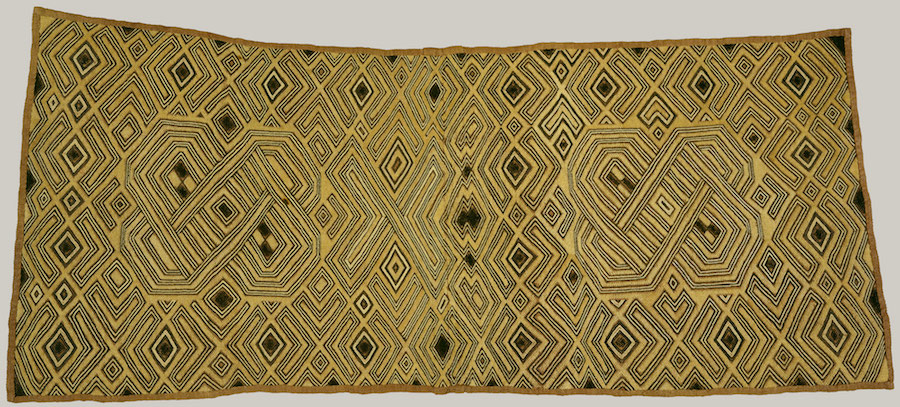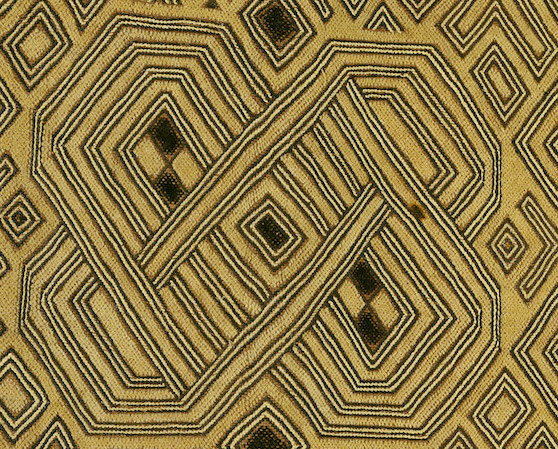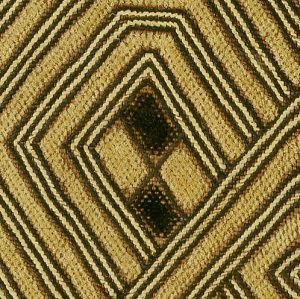
Double Prestige Panel, 19th–20th century, Democratic Republic of the Congo, Sankuru River region, Kuba peoples, raffia palm fiber, 51.4 x 116.2 cm (The Metropolitan Museum of Art)
This double panel of raffia cloth with cut-pile embroidery was created to serve as a prestige item in Kuba society. The Kuba kingdom has a complex political structure composed of independent chiefdoms under the central authority of a king. It was founded in the early seventeenth century by Shyaam a-Mbul a Ngoong (also spelled Shyaam aMbul aNgoong), a ruler who brought together some seventeen different ethnic groups into a unified polity. Shyaam is recalled as a dynamic and innovative leader who introduced a number of important Kuba artistic traditions, including lavish woven and embroidered textiles made of raffia. In fact, the Kuba founding ruler is said to have identified so closely with the patronage of these textiles that he adopted the term for raffia palm, shyaam, as his name.

Detail, Double Prestige Panel, 19th–20th century, Democratic Republic of the Congo, Sankuru River region, Kuba peoples, raffia palm fiber, 51.4 x 116.2 cm (The Metropolitan Museum of Art)
In this complex composition, each panel features a large central interlacing motif against a diamond-patterned background. The dense patterns have been embroidered with strands of dyed raffia fiber that are cut close to the surface, creating a soft, velvety texture. Varying in both tone and texture, the patterns project dramatically from the gold field.

Detail, Double Prestige Panel, 19th–20th century, Democratic Republic of the Congo, Sankuru River region, Kuba peoples, raffia palm fiber, 51.4 x 116.2 cm (The Metropolitan Museum of Art)
The preparation, production, and design of Kuba raffia textiles require the collaborative efforts of both men and women. Men are responsible for cultivating raffia palm trees and collecting the outer layers of the fronds, which yield fiber strands. They weave these strands on a vertical heddle loom into panels of cloth. Individual woven units, known as mbala, are softened and refined to a linen-like texture by pounding. These flat-woven panels may then be decorated and stitched together to form garments. Women assemble and decorate their own skirts, which can be up to nine yards in length. Men fashion their skirts, which can be of greater length and have a border of raffia tufts. Both genders employ a range of decorative processes, including dyeing, appliqué, embroidery, and patchwork, although some distinctive techniques, such as openwork and cut-pile, are practiced only by women. The completed garments are worn differently: women wrap the skirt around their bodies, while men gather the cloth around their hips, secured by a belt with the top folded over.
Some raffia cloth, like this panel, was not fashioned into garments, but was displayed instead as prestige items. In the past, individual panels of raffia textiles were used as objects of exchange in financial, legal, and even marital transactions. They were also displayed and offered as memorial gifts during funerals, as an indication of the deceased’s importance as well as the generosity of the surviving family members. Today, despite the availability of machine- made cotton cloth, raffia textiles are still regarded as the only kind of garment appropriate to adorn the body of the deceased. An important individual may be buried dressed in multiple layers of raffia skirts, often family treasures passed down through generations.
© 2006 The Metropolitan Museum of Art, New York (by permission)


